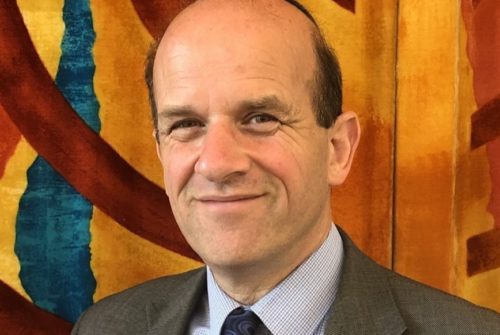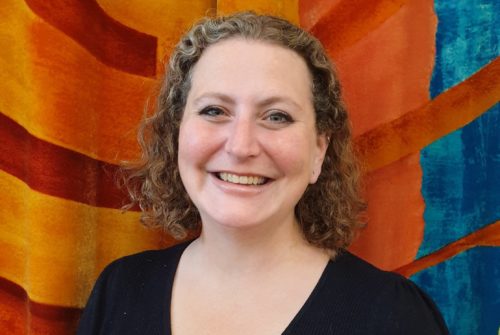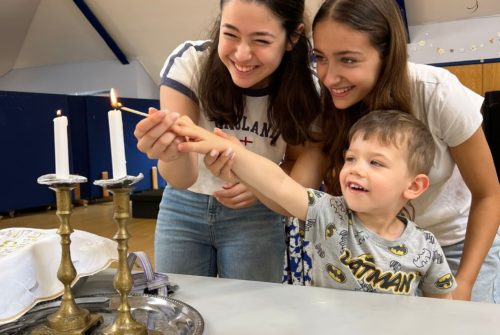If it wasn’t Shabbat today what would be happening all over Israel is that people would be gathering planks of wood, fallen branches, cardboard packaging and mattresses to create bonfires for next Sunday. That’s because it will be Lag b’Omer, the 33rd day of the Omer. The Omer is the period between the festivals of Pesach and Shavuot when we count day by day how long it will be before Shavuot begins. We first hear about the idea in our Torah portion today. Having a Lag B’Omer bonfire is so much part of Israeli culture that even in this year when celebration is so difficult I am sure that it will be as much observed as ever.
The mattress thing is a big problem in Israel. It’s not a good idea to burn mattresses. Indeed according to the Israel Ministry of Environmental Protection the amount of particulate matter in the air on Lag b’Omer can reach up to 10 times the normal average. News reports often show satellite images, which display a plume of smoke covering the whole area of Israel during the festival. So in Bnei Brak, the ultra-orthodox city in the central district of Israel, where the high number of bonfires lit during the holiday affects many of its residents each year, the municipality started a campaign against the burning of health-damaging substances. In an attempt to make Lag B’Omer a little greener, an eco-organization called “Haredim L’Sviva” (ultra-orthodox Jews for the environment), has suggested for the past the lighting of small oil lamps instead of massive bonfires. I rather doubt they get much take up! (Dominik Dohler, i24 News, 11th May 2017)
There are two main inspirations for Lag b’Omer, which, like many Jewish answers to questions, intersect. Number one is the story of Rabbi Akiva’s twenty-four thousand students.
Rabbi Akiva was a remarkable man. An uneducated shepherd he was born around the year 50 in Roman occupied Caesarea. He began his Jewish learning at the age of 40 encouraged by his wife Rachel. Legend has it that he noticed a stone at a well that had been hollowed out by drippings from the buckets, said: “If these drippings can, by continuous action, penetrate this solid stone, how much more can the persistent word of God penetrate the pliant, fleshly human heart, if that word is presented with patient insistence.”
Akiva became one the great teachers of Judaism. Indeed he was executed by the Romans in a particularly gruesome way because he refused to stop teaching Torah when it was banned during the Hadrianic persecutions in 135CE, dying with the words of the Shema on his lips. Early on during the times of these persecutions he had amassed what the Talmud refers to as 12,000 pairs of students (Yevamot 62b). They are called pairs because Akiva had them study in pairs, in the system very popularly practiced in Jewish learning now known as Chavrutah – joining two people together to learn so that each encourages and questions the other. But some Rabbis say that they were called 12,000 pairs of students because they failed to treat each other with proper respect so when a plague of diphtheria broke out among them they did not help each other and virtually all of them died.
And Lag b’omer? The legend continues that it was on the 33rd day of the Omer that the plague stopped and no more students died. So this is why we remember it and this is why there are mourning rituals attached to the period between Pesach and Shavuot including not having weddings take place and, for the observant, not cutting their hair. However because on the 33rd day of the Omer the plague stopped all those hundreds of years ago – it is OK to have a wedding on that particular day or to cut your hair.
Which brings us to the other inspiration for celebrating Lag b’Omer. Having lost all his students Akiva got five more going who became among the greatest teachers of Judaism ever. These included Rabbi Meir, Rabbi Yose, Rabbi Yehudah and Rabbi Elazar ben Shamua. Their words are quoted throughout the Talmud. But perhaps the most influential of Rabbi Akiva’s new students was Rabbi Shimon Bar Yochai.
Shimon Bar Yochai is the Rabbi credited in legend with writing the Zohar, the Kabbalistic book of Jewish mysticism. The word Zohar itself means light and brightness – and indeed Kabbalah is enlightening as it inspires you to understand the Torah in a new light.
Wouldn’t you know that Shimon Bar Yochai died on Lag B’Omer – and so since his light was removed from the world on that day, that is why bonfires are lit in his memory. In something of a wonderful conflation since it is permissible for observant Jews to cut their hair on this day this has become the day that thousands of Chadisim flock to Shimon bar Yochai’s tomb in Meron to give their three-year-old sons their first haircut – in a ceremony known in Yiddish as Upsheren. Literally the shearing! Its an incredible gathering and you may remember it has on occasions become dangerous due to overcrowding and the collapse of inadequate pathways for the numbers of people. Sadly it will almost certainly be cancelled this year as Meron has been attacked this month by rockets aimed by Hezbollah in Lebanon (Jerusalem Post 1/5/24).
There is with one more tradition based on the knowledge that the 24,000 original students of Akiva all died during the Hadrianic persecution period. Further legend fancies that they must have followed Akiva’s support of Simeon Bar Kochba who led the Jewish revolt against Hadrian’s oppression. Hence they must have had bows and arrows, so watch out in Israel next Sunday for loads of children firing bows and arrows in the woods with their dads in commemoration of the students!
Not so much of the Lag B’omer tradition is followed in Britain and the Jewish Diaspora. It’s really something that has a huge cultural following in Israel. But one aspect may have affected many people here today. That is the idea that a Jewish wedding cannot happen between Pesach and Shavuot, which is, being the springtime, otherwise prime wedding season in Britain, with Lag b Omer, next Sunday, as the only day you can marry.
EHRS as a Reform Synagogue does not follow the whole of the Omer practices because of their legendary basis so it is possible to be married through our Synagogue during the Omer. However we always warn any couple that they may find their Orthodox family members unwilling to come or participate fully in a wedding celebration during the Omer so that they can make an informed choice. Thing is though there is a wide variety of different practice around the Omer.
In general, in Sephardi communities observant Jews don’t get married until Lag B’Omer and then it’s OK for a wedding to take place from then until Shavuot and after. In general in Ashkenazi communities observant Jews don’t get married throughout the whole of the Omer period except on Lag B’Omer The same applies to the hair cutting ban, which means that apart from on Lag B’omer there will be some straggly beards around Golders Green.
Why the difference? Rabbi Daniel Sperber, Israeli expert on Minhag, Jewish customs, explains that its to do with something else that happened during the Omer period twelve hundred years later – the Crusades, which swept through the Rhineland during this precise period of the year in 1096. Crusaders on their way to the Holy Land got started once the winter was past and on their way to conquer Islam thought they had better deal with the Jews on the way. Jews were massacred in towns like Speyer, Mainz, Worms, Cologne. Jewish communities with hundreds of years of history were decimated.
For this reason the Omer mourning period in Ashkenazi countries which had had the experience of these massacres became the whole period of 50 days and not only the first 33, these communities remembered more than the plague of Akiva’s students. The Sephardi and the Mizrachi communities of Spain, then Serbia and Greece, Turkey, North Africa and the Middle East did not share the experience.
So why now do we remember? And should we remember more? I think that it is time that we marked Lag b’Omer in our Reform communities. It’s a time to remember the loss of the learning and teaching that affected us when Akiva’s students died but also at other times when the potential for the future has been snuffed out, up to the present day. During the Shoah whole Jewish cultures were destroyed along with their people, it happened too when Jewish communities in Arab countries virtually closed down in the second half of last century, as conditions became impossible – Baghdad, Alexandria, Teheran. Akiva’s students symbolise this loss.
It is a time to remember that there are times when Jews have lived in peril, of Roman oppression, Crusader oppression and Soviet oppression to name but a few. That memory and the celebration on Lag bOmer of the brief passing of the threat galvanises us to celebrate our freedom to learn and to thrive as a people and links us today with the developing culture of Israel.
This year at EHRS, Lag b’Omer will be lovely. The whole congregation is invited to our Lag B’Omer garden party taking place in Anita Tischler’s beautiful garden in Barnet – there will be games including archery and cos its England croquet and I am sure some toasted marshmallows on the barbeque in the garden, hearing the stories of Rabbi Akiva. Please do book yourselves in and let’s join Israel and the Jewish world in this festival and commemoration that has been almost lost to us. And please don’t bring a mattress to burn!



